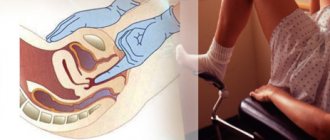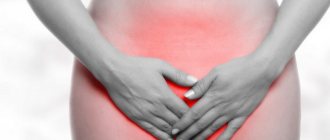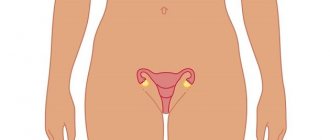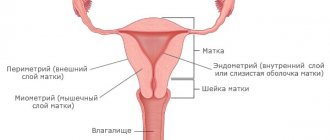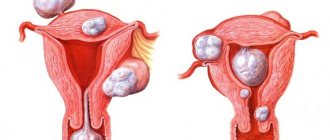A woman, while pregnant, undergoes a huge number of changes. The baby that grows inside her every day contributes to hormonal surges, a weakening of the immune system, enlargement of the mammary glands and, of course, along with all this restructuring of the body, the uterus also enlarges, and significantly.
The fact is that the uterus is a unique organ; during the entire pregnancy it can increase more than 500 times . And then, after the baby sees the light, the uterus can return to its previous size.
And for some girls this return may take a minimal amount of time. Of course, others should work hard for similar results. There are known factors that can influence a more rapid contraction of the uterus after childbirth, and there are also those that can delay this process.
Is there a specific answer to the question - how much does the uterus contract after childbirth? Let's try to figure it out.
The process of contraction of the uterus after childbirth
After the baby is born, the uterus is like a huge wound and not only is it similar, it is one. And the place where the placenta was attached is considered the most damaged, due to the fact that a large number of thrombosed vessels remain there.
Medicine believes that in the absence of pathologies, the uterus is cleansed within 3 days. This occurs thanks to phagocytes, these are leukocytes that dissolve bacteria, this process is called phagocytosis and at the same time extracellular proteolysis occurs - this is when bacteria are dissolved due to proteolytic enzymes.
Both of these processes contribute to the fact that the uterus secretes the wound secretion “sucker”. If in the first days lochia looks like bloody discharge, then on the 3-4th day the discharge resembles ichor.
And the more time passes, the more the lochia brightens. For example, at the end of the 3rd week it is considered normal when the discharge is liquid and light. And at this rate, by the 6th week there should be no more discharge.
It takes 3 weeks for the epithelium of the uterine cavity to fully recover. But the place where the placenta was kept will return to normal after the postpartum period.
How long should it take?
The uterus, of course, contracts most quickly in the first time after childbirth. But it can take up to two and a half months to return to its previous form.
For example, in the first postpartum minutes, the diameter of the uterine pharynx is 12 cm. Thus, nature made sure that the obstetrician could stick his hand in to remove the remnants of the placenta.
After a day passes after birth, the size of the uterine pharynx is equal to two fingers, after three days - one finger. Complete closure of the uterine os occurs after 3 weeks.
It is very important that the contracting uterus is accompanied by cramping pain in the lower abdomen. Moreover, if after the first birth a girl may not feel these pains, then after repeated births such pains are most pronounced.
If the girl is unable to survive these painful contractions, then it is better to consult a doctor who will prescribe a pain reliever. But when breastfeeding, it is best to refuse medications, especially at first, and endure the pain.
In some cases, the uterus does not contract at all after childbirth, this phenomenon is called atony or it contracts barely - hypotension.
Both options pose a danger to a woman’s health, as they can cause postpartum hemorrhage or any other fairly serious complication.
Complications
In some situations, in the immediate moments after birth, difficulties with women's health may arise. Such complications are:
- violation of uterine contraction;
- the occurrence of an inflammatory process as a result of infection;
- formation of uterine bleeding.
These phenomena do not exist on their own, but are combined; each can become the source or culprit of the other. For example, a weakly contracted uterus can cause bleeding, and infection can cause an inflammatory process inside the uterus - endometritis.
To prevent complications, it is necessary that the cleansing process be under control.
The reproductive organ may drop. Postpartum prolapse is its displacement downward from its usual place. The ultimate stage of descent is prolapse, when the organ, in whole or in part, comes out. There is a point of view that natural childbirth, especially repeated and complicated by ruptures, is to blame for prolapse. In fact, this is one of the reasons, but not the main one. Experts say that the key reason is the specificity of the body’s connective tissues, flaccid perineal muscles, as well as unsuccessful repair of tears.
The pelvic muscles injured during childbirth displace all the female organs that they previously supported. Signs of uterine prolapse after childbirth are painful sensations. However, it may not manifest itself in any way for many years. Older women are most at risk of getting this disease, although younger women are not immune from it. The common diagnosis of “prolapse of the cervix” after childbirth is associated with the first; their therapy, manifestations and preventive measures are similar.
Pathological prolapse of the cervix after childbirth is expressed by symptoms:
- aching pain in the lower abdomen;
- sudden pain in the vaginal area and lumbar region;
- enuresis;
- pain during sexual intercourse.
Why doesn't the uterus contract?
Gynecology identifies factors that help slow down uterine contractions after childbirth:
- multiple pregnancy;
- the placenta is not located normally;
- complications during pregnancy and childbirth;
- large fruit;
- physical and psychological state of the woman in labor and the like.
The uterus contracts much more slowly in women whose pregnancy:
- accompanied by complications;
- was multiple;
- accompanied by low placental attachment;
- carried a large fetus;
- occurred with weakened immunity;
- labor was not active;
- After giving birth, the woman slept almost all the time and did not move at all.
The uterus does not contract categorically when:
- inflection;
- any trauma to the birth canal;
- underdevelopment of the uterus itself;
- past or present inflammation of the genitourinary system;
- fibroids;
- accompanying pregnancy with plenty of water;
- impaired blood clotting and other factors.
What to do if the uterus is contracting slowly?
After the baby is born, a cold heating pad is immediately placed on the mother's lower abdomen. This is done in order to stop the bleeding and begin the process of contracting the uterus.
During the days that the woman in labor is in the maternity hospital, doctors will monitor the condition of the uterus and the level of its contraction. And if, upon examination by a doctor, it turns out that the fundus of the uterus is soft, then this will give him a reason to note the low ability of the uterus to contract.
And until the doctor is sure that the contraction of the uterus after childbirth occurs at a normal pace, there will be no discharge.
It also happens that a gynecologist ascertains the fact that the uterus is not able to contract on its own, then the doctor prescribes drugs to the woman who has just given birth that promote contraction of the uterus.
These are mainly drugs such as prostaglandins or oxytocin; at the same time, external massage of the uterine fundus, carried out on the anterior abdominal wall, is recommended.
As strange as it may seem, breastfeeding is a stimulating effect for uterine contractions. And this is worth taking note!
In the absence of contraindications, a girl after childbirth needs to move as often as possible, and, if possible, she needs to lie on her stomach or even sleep on it. Of course, the rules of personal hygiene have not disappeared anywhere; every woman knows that they should be followed in any situation.
In addition, the contractile properties of the uterus are also affected by the fact that the bladder should not be overfilled. It is important to have bowel movements frequently, even with internal stitches, when every trip to the toilet brings unimaginable pain.
By the way, the uterus after childbirth contracts much more often in those representatives of the fairer sex who did not avoid physical activity during pregnancy, moved actively and did all the housework themselves, of course, within reasonable limits.
Fresh air plays an important role here - so dear pregnant women, go for an evening walk in the fresh air.
If you have tried all the methods, but the effect is zero, then you will have to resort to cleaning; sometimes it happens that lochia remains in the uterus, particles of the placenta, or the uterine pharynx is clogged with blood clots.
Cleaning must be done if there are indications for it, since an advanced form can lead to inflammation both in the uterus itself and around it.
If cleaning does not bring the required results, then surgery is prescribed. But to reassure pregnant women reading this article, we note that such an outcome is extremely rare.
And even more so, if a pregnant woman takes care of her health, follows all doctor’s orders, and has eradicated bad habits, then nothing will spoil her happiness from childbearing and everything will end in the most positive way for her!
If the uterus is delayed in its contraction, this phenomenon is called uterine subinvolution.
The norm is considered to be a return to previous size in nursing mothers by the sixth week and in non-breastfeeding mothers by the eighth week.
Hormonal changes occur in the woman's body. Growth hormone stops its production and substances designed to restore the body take over.
Nature made sure that the woman’s body returned to normal as quickly as possible after childbirth. And if everything goes well, then the uterus contracts accordingly.
And if the uterus suddenly begins to contract, either with a delay, or decides not to contract at all, this is a signal that the body has malfunctioned, not only in terms of the immune system, but also in hormonal terms.
An indisputable factor in which the uterus contracts poorly is Caesarean section. And therefore, recently, women in labor who have undergone a Caesarean section have been advised to get up as early as possible, be active and move as often as possible, otherwise prolonged inactivity can lead to muscle weakness, including the uterine muscles.
Massage procedure
To glide your hands over the skin, use any baby oil, a mixture of oils taken for the base (almond, avocado, peach or grape seed) - 50 ml, with your favorite essential oils (10 drops). In a course of 10-15 procedures, the first three sessions last 30-45 minutes, the subsequent ones – 45-60 minutes.
The woman is laid on her back, her legs are slightly bent at the knee joints and a cushion is placed, her arms are along her body. The massage is performed after meals, after 1.5 hours. First, a woman needs to empty her bladder and intestines, since performing abdominal massage after childbirth affects the muscles, intestinal tract, bladder and uterus.
Circular movements clockwise across the abdomen are performed precisely along the intestinal tract, and they improve intestinal motility. Next, perform all the techniques of stroking the oblique abdominal muscles, directing movements from the lower ribs to the pelvic bones, then stroke the rectus abdominis muscle with the palmar surfaces or the back of the hands in both directions, which relieves abdominal tension.
Abdominal wall.
- gentle, circular, flat stroking from the navel over the entire surface in a clockwise direction;
- rubbing: sawing, shading, grinding (crossing);
- longitudinal, transverse kneading, felting, rolling and vibration - according to indications;
Rectus abdominis muscles.
Massage by stroking, pincer-like, ironing, kneading from top to bottom and vice versa, shaking and ending with stroking.
For better intestinal motility, removal of carcinogens, broken down fat, and other excess ballast, a massage of the stomach, small and large intestines is performed according to indications.
Stomach.
Massage while lying on your back and on your right side. Relax the abdominal muscles and begin to influence the stomach, the bottom of which reaches the fifth rib along the midclavicular line on the left, and the lower border is located in the abdominal wall in the front, 1-2 cm above the navel in women.
Causes of delayed uterine contraction:
Contraction of the uterus may occur with a delay due to hormonal imbalances, disturbances in the anatomy of the body, or a banal infection.
Hormonal imbalances
Insufficient amount of the hormone that is responsible for the production of breast milk - prolactin.
The fact is that prolactin is the main parental hormone and it should be present in sufficient quantities during the first 24 hours, even in those who do not breastfeed initially.
The production of oxytocin, a hormone that causes the muscles of the uterus to contract, depends on the production of prolactin.
Anatomical background
If after childbirth the placenta remains in the uterus. attached to the wall of the uterus, the stiff uterus cannot contract fully.
By the way, bending of the uterus or blockage of the external pharynx and other folk myths remain just that: myths.
Infection
If a woman has a postpartum infection, then most likely it was already in her body, because in sterile conditions it is almost impossible to introduce any infection.
Postpartum endometritis develops if a pregnant woman has suffered from inflammation of the membranes, chorionic disease. The inflamed surface of the uterus becomes flabby and cannot be stimulated by oxytocin.
In any case, the reasons why the uterus does not contract or does so slowly are identified in the maternity hospital and treated immediately.
It must be said that any complications associated with postpartum uterine contractions are a rare occurrence. Basically, for women in labor, everything always goes well, without any deviations.
Main. Take care of yourself and your health during pregnancy, because the expectant mother is no longer alone!
Features of postpartum gymnastics
Postpartum gymnastics in the first weeks is characterized by the absence of serious stress on the body and consists mainly of alternating tension and relaxation of muscle groups. Such gymnastics serves, among other things, as an excellent prevention of uterine prolapse. These exercises should be done not only if the involution of the uterus is slow, but also if there are no problems to shorten the recovery period. You can start exercising the very next day after giving birth (provided there are no stitches or complications). After a cesarean section, classes will have to be postponed until the stitches heal. As a rule, after 7–10 days the doctor allows a small load. Thanks to gymnastics, the tone of the pelvic floor and abdominal muscles will be normalized, uterine contraction will accelerate, blood circulation will improve, and the abdominal and pelvic organs will return to their places. Contraindications for performing gymnastics:
- heat;
- cardiovascular diseases in the acute stage;
- infections;
- severe blood loss;
- significant perineal tears.
